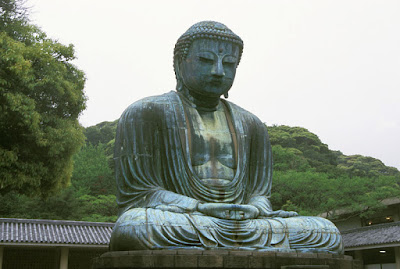Japan, the Third Day
Toshi, his wife Hiroko, and daughter Erika came all the way into Tokyo to pick me up at the ryokan and took me to Kamakura, the third capital city of Japan. (Japan History, completely worth reading.) (Kamakura period.)
One of the AMAZING things about Japan is that their written history goes back...oh...say, 16-17 CENTURIES. Japan is eight or nine times as old as we are. To stand near the huge wooden shrines is to feel the age rolling off them. To understand Japanese history at all, it's important to get a sense of just how long 1900 years really IS.
Kamakura was the capital of Japan from 1185-1333, about 150 years, and it's the kind of place I never would have visited had I been on my own. There is so much to see in Japan--1900 years leaves a lot of history--that it would have simply fallen off my list, in spite of its mention in several guidebooks, and I would have never seen a Shinto wedding, the second-largest Buddha in the world, or a bamboo forest.
From my travel journal:
"Kamakura is small and pretty traditional, a city of old-fashioned streets and temples. Comparable to Toledo, in Spain, although of course a world removed. Very narrow streets, even for Japan, and driving is very difficult, but everyone does it. Have seen Hokokuji, the Bamboo Temple--a whole forest of bamboo, incredible--we drank green tea looking out at the swaying, creaking green towers, so tall. An amazing noise.
Japanese gardens, I have noticed, are absolutely filled with stone sculptures, all looking like variations on theme on the ones I saw in the Kyu-Shiba-rikyu Gardens. I mentioned this to the Moris, asking them what they were and why they were, and they tried to explain to me--some normal kind of Japanese garden decoration, nothing special. "Like garden gnomes," I said, making a joke, and both the older Moris tried very politely to understand what I meant. Erika, the 11-year-old, got it right away--she was born in New York and raised in Germany, and she gets my cultural references, which is very...welcoming. Hiroko, Toshi's wife, is perfectly stunning, and I am not surprised when she tells me she was a flight attendant for Japan Air. We laughed together about planes and airlines, once I told her I worked for Boeing. She keeps saying her English was bad, but if it was, I couldn't see how. Toshi, of course, is gracious, giving, generous, sociable, funny, and very patient with my blunderings around Japanese culture." (End Journal Entry.)
Some pictures from the web, since I was still sans camera:
A shot from Flickr.
And finally, me!
| From Japan |
Again from my journal:
"At the Tsurugaoka Hachiman Shrine, site of some of Japan's most sordid history, I got the chance to see a Shinto Wedding, which the Moris assured me was very rare. I curse my lack of camera, as the headdress of the bride and costumes of the bride and groom are exquisite, exotic, almost alien. The melancholy music of the Shinto wedding reminds me of bagpipe music that doesn't resolve. I see a stringed instrument like a guitar, a long kind of sitar, a set of gongs and bells, and that's all I can recognize. The Shinto shrines remind me of our Pacific Northwest longhouses, a comparison helped out by the relatively identical scenery--only Japan has fewer evergreens." (End Journal entry.)
History of the Tsurugaoka Hachiman Shrine. Watch for this story to appear again when I cover Kabuki Theater.
And finally, one big fella:
 |
| From Japan |
You can go inside him for 20 Yen, but we chose not to.
| From Japan |
Notes for my Buddhist Readers: This is the Great Buddha, the Daibatsu. I very carefully remembered that all the way across the Pacific, so I damn well hope it means something to you.

No comments:
Post a Comment